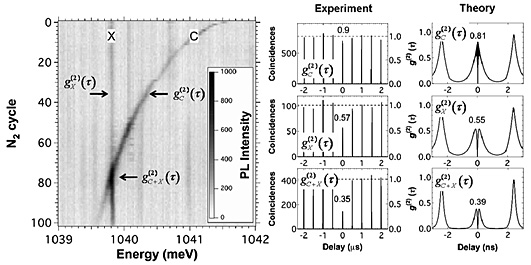Optical Science Research Laboratory, *Queen’s University
Interaction between single exciton and single cavity mode are fundamentally
interesting and useful in the context of single-photon source for quantum
information processing. A curious feature in recent studies using semiconductor
photonic-crystal (PhC) is much brighter cavity emission under large detuning
than theoretically expected from standard emission formulas [1]. Here,
we undertake an experimental study to identify the cavity mode emission
at non-zero detuning and its influence on single photon statistics [2].
We use PhC cavities which consist of a GaAs membrane containing a single
InAs dot layer. The left panel of Fig. 1 is image of PL intensity mapping
with cavity mode detuning at 4 K. The GaAs barrier was excited by Ar-ion
laser (2.54 eV) in this measurement. We found that this system show the
bright cavity emission even under fairly-large detunings. The integrated
PL intensity when the cavity mode and the exciton are resonant (zero detuning),
increases by a factor of about 9 compared with the off resonant case.
To explore the influence of the cavity emission on the photon statistics,
we measured the second-order autocorrelation function of the photon intensity.
When off-resonant cavity mode, anti-bunching was not observed where g
This work was partially supported by Strategic Information and Communications
R&D Promotion Programme (SCOPE) of Japan.
[1] For example, K. Hennessy et al., Nature 445 (2007) 896.
[2] T. Tawara et al., Opt. Express 17 (2009) 6643.
 |
||
|